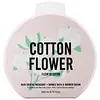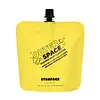What's inside
What's inside
 Key Ingredients
Key Ingredients

 Benefits
Benefits

 Concerns
Concerns

 Ingredients Side-by-side
Ingredients Side-by-side

Water
Skin ConditioningAmmonium Lauryl Sulfate
CleansingGlycerin
HumectantCocamidopropyl Betaine
CleansingParfum
MaskingSodium Chloride
MaskingStyrene/Acrylates Copolymer
Sodium Benzoate
MaskingCitric Acid
BufferingPotassium Sorbate
PreservativeBenzoic Acid
MaskingDiethylhexyl Syringylidenemalonate
Skin ProtectingTetrasodium Glutamate Diacetate
Caprylic/Capric Triglyceride
MaskingTocopheryl Acetate
AntioxidantSodium Hydroxide
BufferingGossypium Herbaceum Extract
Skin ConditioningCI 17200
Cosmetic ColorantWater, Ammonium Lauryl Sulfate, Glycerin, Cocamidopropyl Betaine, Parfum, Sodium Chloride, Styrene/Acrylates Copolymer, Sodium Benzoate, Citric Acid, Potassium Sorbate, Benzoic Acid, Diethylhexyl Syringylidenemalonate, Tetrasodium Glutamate Diacetate, Caprylic/Capric Triglyceride, Tocopheryl Acetate, Sodium Hydroxide, Gossypium Herbaceum Extract, CI 17200
Water
Skin ConditioningSodium Lauroyl Methyl Isethionate
CleansingCocamidopropyl Betaine
CleansingSodium C14-16 Olefin Sulfonate
CleansingGlycerin
HumectantSalix Alba Bark Extract
AstringentSodium Chloride
MaskingGluconolactone
Skin ConditioningSodium Benzoate
MaskingTrisodium Ethylenediamine Disuccinate
Cocamidopropyl Dimethylamine
EmulsifyingCitric Acid
BufferingSodium Lactate
BufferingSodium Hydroxide
BufferingSodium PCA
HumectantLimonene
PerfumingLinalool
PerfumingMelia Azadirachta Leaf Extract
Skin ConditioningGlycolic Acid
BufferingLactic Acid
BufferingMalic Acid
BufferingCalcium Gluconate
HumectantMelia Azadirachta Flower Extract
Skin ConditioningButyrospermum Parkii Butter
Skin ConditioningCitronellol
PerfumingCocos Nucifera Water
MaskingPyruvic Acid
MaskingTartaric Acid
BufferingCentella Asiatica Leaf Extract
Skin ConditioningGeraniol
PerfumingHydrolyzed Oat Protein
Skin ConditioningCamellia Oleifera Leaf Extract
AstringentPhospholipids
Skin ConditioningSodium Carbonate
BufferingLeuconostoc/Radish Root Ferment Filtrate
AntimicrobialCocos Nucifera Fruit Juice
EmollientTocopheryl Acetate
AntioxidantBenzyl Alcohol
PerfumingAscorbyl Palmitate
AntioxidantCholecalciferol
Pantothenic Acid
Skin ConditioningRetinyl Palmitate
Skin ConditioningPotassium Sorbate
PreservativeParfum
MaskingWater, Sodium Lauroyl Methyl Isethionate, Cocamidopropyl Betaine, Sodium C14-16 Olefin Sulfonate, Glycerin, Salix Alba Bark Extract, Sodium Chloride, Gluconolactone, Sodium Benzoate, Trisodium Ethylenediamine Disuccinate, Cocamidopropyl Dimethylamine, Citric Acid, Sodium Lactate, Sodium Hydroxide, Sodium PCA, Limonene, Linalool, Melia Azadirachta Leaf Extract, Glycolic Acid, Lactic Acid, Malic Acid, Calcium Gluconate, Melia Azadirachta Flower Extract, Butyrospermum Parkii Butter, Citronellol, Cocos Nucifera Water, Pyruvic Acid, Tartaric Acid, Centella Asiatica Leaf Extract, Geraniol, Hydrolyzed Oat Protein, Camellia Oleifera Leaf Extract, Phospholipids, Sodium Carbonate, Leuconostoc/Radish Root Ferment Filtrate, Cocos Nucifera Fruit Juice, Tocopheryl Acetate, Benzyl Alcohol, Ascorbyl Palmitate, Cholecalciferol, Pantothenic Acid, Retinyl Palmitate, Potassium Sorbate, Parfum
Ingredients Explained
These ingredients are found in both products.
Ingredients higher up in an ingredient list are typically present in a larger amount.
Citric Acid is an alpha hydroxy acid (AHA) naturally found in citrus fruits like oranges, lemons, and limes.
Like other AHAs, citric acid can exfoliate skin by breaking down the bonds that hold dead skin cells together. This helps reveal smoother and brighter skin underneath.
However, this exfoliating effect only happens at high concentrations (20%) which can be hard to find in cosmetic products.
Due to this, citric acid is usually included in small amounts as a pH adjuster. This helps keep products slightly more acidic and compatible with skin's natural pH.
In skincare formulas, citric acid can:
While it can provide some skin benefits, research shows lactic acid and glycolic acid are generally more effective and less irritating exfoliants.
Most citric acid used in skincare today is made by fermenting sugars (usually from molasses). This synthetic version is identical to the natural citrus form but easier to stabilize and use in formulations.
Read more about some other popular AHA's here:
Learn more about Citric AcidCocamidopropyl Betaine is a fatty acid created by mixing similar compounds in coconut oil and dimethylaminopropylamine, a compound with two amino groups.
This ingredient is a surfactant and cleanser. It helps gather the dirt, pollutants, and other impurities in your skin to be washed away. It also helps thicken a product and make the texture more creamy.
Being created from coconut oil means Cocamidopropyl Betaine is hydrating for the skin.
While Cocamidopropyl Betaine was believed to be an allergen, a study from 2012 disproved this. It found two compounds in unpure Cocamidopropyl Betaine to be the irritants: aminoamide and 3-dimethylaminopropylamine. High-grade and pure Cocamidopropyl Betaine did not induce allergic reactions during this study.
Learn more about Cocamidopropyl BetaineGlycerin is already naturally found in your skin. It helps moisturize and protect your skin.
A study from 2016 found glycerin to be more effective as a humectant than AHAs and hyaluronic acid.
As a humectant, it helps the skin stay hydrated by pulling moisture to your skin. The low molecular weight of glycerin allows it to pull moisture into the deeper layers of your skin.
Hydrated skin improves your skin barrier; Your skin barrier helps protect against irritants and bacteria.
Glycerin has also been found to have antimicrobial and antiviral properties. Due to these properties, glycerin is often used in wound and burn treatments.
In cosmetics, glycerin is usually derived from plants such as soybean or palm. However, it can also be sourced from animals, such as tallow or animal fat.
This ingredient is organic, colorless, odorless, and non-toxic.
Glycerin is the name for this ingredient in American English. British English uses Glycerol/Glycerine.
Learn more about GlycerinParfum is a catch-all term for an ingredient or more that is used to give a scent to products.
Also called "fragrance", this ingredient can be a blend of hundreds of chemicals or plant oils. This means every product with "fragrance" or "parfum" in the ingredients list is a different mixture.
For instance, Habanolide is a proprietary trade name for a specific aroma chemical. When used as a fragrance ingredient in cosmetics, most aroma chemicals fall under the broad labeling category of “FRAGRANCE” or “PARFUM” according to EU and US regulations.
The term 'parfum' or 'fragrance' is not regulated in many countries. In many cases, it is up to the brand to define this term.
For instance, many brands choose to label themselves as "fragrance-free" because they are not using synthetic fragrances. However, their products may still contain ingredients such as essential oils that are considered a fragrance by INCI standards.
One example is Calendula flower extract. Calendula is an essential oil that still imparts a scent or 'fragrance'.
Depending on the blend, the ingredients in the mixture can cause allergies and sensitivities on the skin. Some ingredients that are known EU allergens include linalool and citronellol.
Parfum can also be used to mask or cover an unpleasant scent.
The bottom line is: not all fragrances/parfum/ingredients are created equally. If you are worried about fragrances, we recommend taking a closer look at an ingredient. And of course, we always recommend speaking with a professional.
Learn more about ParfumPotassium Sorbate is a preservative used to prevent yeast and mold in products. It is commonly found in both cosmetic and food products.
This ingredient comes from potassium salt derived from sorbic acid. Sorbic acid is a natural antibiotic and effective against fungus.
Both potassium sorbate and sorbic acid can be found in baked goods, cheeses, dried meats, dried fruit, ice cream, pickles, wine, yogurt, and more.
You'll often find this ingredient used with other preservatives.
Learn more about Potassium SorbateSodium Benzoate is a preservative. It's used in both cosmetic and food products to inhibit the growth of mold and bacteria. It is typically produced synthetically.
Both the US FDA and EU Health Committee have approved the use of sodium benzoate. In the US, levels of 0.1% (of the total product) are allowed.
Sodium benzoate works as a preservative by inhibiting the growth of bacteria inside of cells. It prevents the cell from fermenting a type of sugar using an enzyme called phosphofructokinase.
It is the salt of benzoic acid. Foods containing sodium benzoate include soda, salad dressings, condiments, fruit juices, wines, and snack foods.
Studies for using ascorbic acid and sodium benzoate in cosmetics are lacking, especially in skincare routines with multiple steps.
We always recommend speaking with a professional, such as a dermatologist, if you have any concerns.
Learn more about Sodium BenzoateChances are, you eat sodium chloride every day. Sodium Chloride is also known as table salt.
This ingredient has many purposes in skincare: thickener, emulsifier, and exfoliator.
You'll most likely find this ingredient in cleansers where it is used to create a gel-like texture. As an emulsifier, it also prevents ingredients from separating.
There is much debate on whether this ingredient is comedogenic. The short answer - comedogenic ratings don't tell the whole story. Learn more about comegodenic ratings here.
The concensus about this ingredient causing acne seems to be divided. Research is needed to understand if this ingredient does cause acne.
Scrubs may use salt as the primary exfoliating ingredient.
Learn more about Sodium ChlorideSodium Hydroxide is also known as lye or caustic soda. It is used to adjust the pH of products; many ingredients require a specific pH to be effective.
In small amounts, sodium hydroxide is considered safe to use. However, large amounts may cause chemical burns due to its high alkaline.
Your skin has a natural pH and acid mantle. This acid mantle helps prevent harmful bacteria from breaking through. The acid mantle also helps keep your skin hydrated.
"Alkaline" refers to a high pH level. A low pH level would be considered acidic.
Learn more about Sodium HydroxideTocopheryl Acetate is AKA Vitamin E. It is an antioxidant and protects your skin from free radicals. Free radicals damage the skin by breaking down collagen.
One study found using Tocopheryl Acetate with Vitamin C decreased the number of sunburned cells.
Tocopheryl Acetate is commonly found in both skincare and dietary supplements.
Learn more about Tocopheryl AcetateWater. It's the most common cosmetic ingredient of all. You'll usually see it at the top of ingredient lists, meaning that it makes up the largest part of the product.
So why is it so popular? Water most often acts as a solvent - this means that it helps dissolve other ingredients into the formulation.
You'll also recognize water as that liquid we all need to stay alive. If you see this, drink a glass of water. Stay hydrated!
Learn more about Water